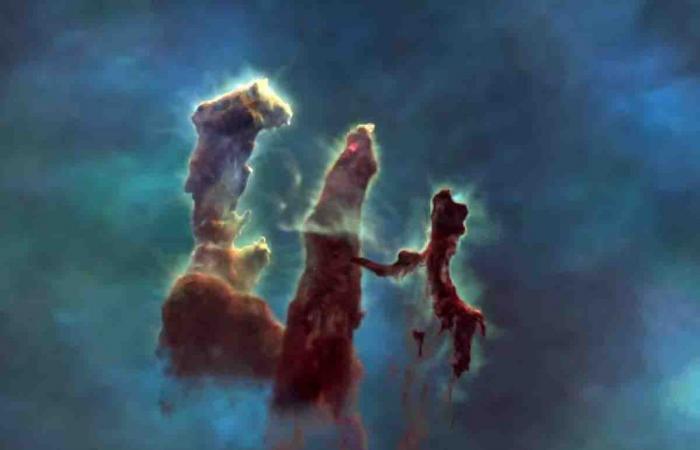The glittering towers of cosmic dust and gas at the heart of the Eagle Nebula have inspired awe for decades, ever since they were first captured by the Hubble Space Telescope. Today, NASA has released the most detailed visualization yet of the iconic celestial structure, revealing all of its dreamlike features through multiple wavelengths of light.
Using data from the Hubble and Webb space telescopes, NASA astrophysicists have weaved an unprecedented journey through the Pillars of Creation, exploring the three-dimensional structure and revealing the dust clouds and embedded stars that make up its finger-like features. The 3D visualization is based on observational data from an article published in the Meteoritic & Planetary Science Journal.
NASA has produced a 2.5-minute video that allows viewers to experience the Pillars of Creation in both visible light, captured by Hubble, and infrared light, captured by Webb. Frank Summersprincipal visualization scientist who led the video development team for NASA’s Learning Universe, said:
By flying between the pillars, viewers can experience their three-dimensional structure and see how different they appear in Hubble’s visible-light view compared to Webb’s infrared view. The contrast helps explain why we have more than one space telescope to observe different aspects of the same object.
The Hubble Telescope sees objects glowing in visible light at higher temperatures. Webb’s infrared vision, on the other hand, is sensitive to cooler objects with temperatures of a few hundred degrees. As a result, Webb is able to penetrate through the dark dust to see stars embedded in the pillars.
Hubble displays the pillars with dark brown, opaque dust and bright yellow ionized gas on a blue-green background, while Webb’s image features nearly transparent orange and orange-brown dust with light blue ionized gas on a dark blue background.
Cosmic wonders
The visualization also highlights different stages of star formation. At the top of the central pillar, there is an embedded newborn protostar that glows deep red in infrared light. Then, a diagonal jet of material ejected from a newborn star can be seen near the top of the left pillar. The jet indicates the birth of a star, even if we cannot see the star itself. Finally, a bright new star shines towards the end of one of the “fingers” of the left pillar.
The Pillars of Creation span approximately 4-5 light years, a relatively small feature of the massive Eagle Nebula, which spans 70×55 light years. The nebula is located 7,000 light-years from Earth in the constellation of the Serpent, but is so bright that it can be seen with a small telescope. Its pillars, meanwhile, were first made famous by Hubble in 1995 with a stunning debut that remains one of the most iconic astronomical images of all time, as highlighted by Mark Clampindirector of NASA’s astrophysics division:
When we combine observations from NASA space telescopes across different wavelengths of light, we broaden our understanding of the universe. The Pillars of Creation region continues to offer us new insights that refine our understanding of how stars form. Now, with this new visualization, everyone can experience this rich and fascinating landscape in a new way.






